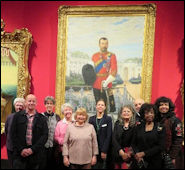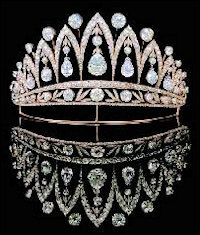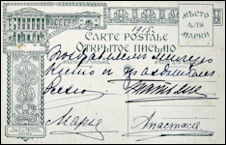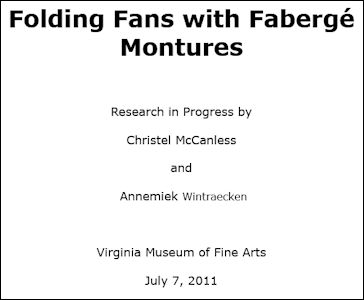In the Spring of 2019, it was my privilege to travel to London (UK) and Houston (Texas) to meet Fabergé Research Newsletter readers, several of whom I had never met in person. In London, 15 enthusiasts hailing from Italy, the Netherlands, Slovenia, United Kingdom and the USA viewed Fabergé objects in the Science Museum, at Wartski’s, the British antique jewelry store specializing in Fabergé, and the Queen’s Gallery in Buckingham Palace. Our thanks to Nancy McCullough from California for organizing this exciting adventure.

John Jenkins (lower right) Treated Fabergé
Enthusiasts to a Traditional English
Meal at the London Union Jack Club
(Photograph Courtesy John Jenkins,
Who Celebrated His 90th Birthday in
September 2019!)
CLICK THE ABOVE PICTURES FOR A LARGER VIEW
Kieran McCarthy Sharing an Holmström Design Book and Three Thrilled Ladies Holding Empress Alexandra’s
Aquamarine Engagement Brooch Featured on the 2006 Wartski Exhibition Catalog
(Courtesy Greg Daubney and Wartski)
- Science Museum – The Last Tsar: Blood and Revolution, explored the last days of Emperor Nicholas II and his family, and the forensic investigation into their murder. Objects of special interest were two Fabergé eggs, the 1915 Red Cross Tryptic and the 1916 Steel Military Eggs presented to Empress Alexandra Feodorovna, on loan from the Cleveland (Ohio) Museum of Art and the Armoury Museum from Moscow, Russia, the chandelier from the dining room of the Ipatiev Palace in Ekaterinburg, the last residence of the Russian Imperial family, and the Nicholas II’s jewelry album. (More details in the essay, Jewel Album of Tsar Nicholas II)
- Kieran McCarthy, joint managing director of Wartski, treated the enthusiasts to an informative “show-and-tell” journey through one of the two original Holmström design books (dated March 1909 – March 1915). They form the basis of A. Kenneth Snowman’s 1993 monograph, Fabergé: Lost and Found, The Recently Discovered Jewelry Designs from the St. Petersburg Archives. The new Wartski store on St. James’s street in London is stunning indeed! Listening to Kieran’s first-hand account of finding in 2014 the long-lost 1887 Third Imperial Easter Egg in the mid-west of the USA kept us all spell-bound. The visit ended with a final treat for the ladies – and the gentlemen present – a close-up examination of the gold-mounted aquamarine brooch made by the Fabergé firm and acquired on August 10, 1894, by Nicholas II for his bride Princess Alix of Hesse. (Fabergé and the Russian Jewellers: A Loan Exhibition, 2006, illustrated in #4 above)
- Queen’s Gallery event at Buckingham Palace included seeing the exhibition entitled, Russia, Royalty & the Romanovs and attending the one-day international conference, Russia: Courtly Gifts and Cultural Diplomacy, sponsored by Cambridge Courtauld Russian Art Centre (CCRAC) and the Burlington Magazine. Fascinating academic research presentations related to the exhibition’s theme –
Through war, alliance and dynastic marriage the relationships between Britain and Russia and their royal families are explored from Peter the Great’s visit to London in 1698 through to Nicholas II with portraits, sculpture, photographs, archival documents, miniature masterpieces, and three eggs by Fabergé from the Royal Collection. The 2018 monograph, Russia: Art, Royalty and the Romanovs by Caroline de Guitaut and Stephen Patterson was published in conjunction with the exhibition now on view from June 21 – November 3, 2019, at The Queen’s Gallery, Palace of Holyroodhouse, Edinburgh, Scotland.
Independent scholar and Fabergé Research Newsletter contributor Cynthia Coleman Sparke spoke about Fabergé Hardstones in Imperial Gifting from Russia to England with an emphasis on an agate kovsh presented by Emperor Nicholas II on October 3, 1896, to Victor Albert Francis Spencer (1864-1934), 3rd Baron Churchill (later 1st Viscount Churchill). Archival documents revealed not only the cost of the gift and the identity of the recipient – an English courtier at Balmoral – but were a basis of comparison with other presents ordered from Fabergé for the 1896 visit to Queen Victoria. An evening reception with a tour by Caroline de Guitaut, senior curator of decorative arts of the Royal Collection Fund, and a viewing of the Russia, Royalty & the Romanovs exhibition ended our very informative study day, and a fabulous Fabergé adventure in London!
- Through the generosity of the McFerrin Foundation and the Houston Museum of Natural Science the Fabergé Happening event was held on April 15, 2019, in the USA. A dozen Fabergé Research Newsletter readers from Alabama, California, Georgia, New York City, and Oregon joined active volunteers and members for a docent training day at the museum.
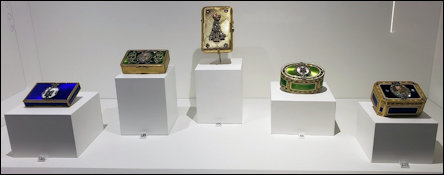
Presentation Pieces with Imperial Cyphers in the McFerrin Collection
(Photograph Christel McCanless)
CLICK THE ABOVE PICTURE FOR A
LARGER VIEW
McFerrin Gallery Layout Map
(Courtesy Jennifer McFerrin Bohner)
Fabergé – The
McFerrin Collection:
The Art of
Presentation, 2019
Delicious Treats – Fabergé
Egg Cookies
(Photograph Gail Peterkin)
Jennifer McFerrin-Bohner introduced the new layout with a gallery map (see above picture, 2nd from the left) featuring Imperial presentation pieces in the Fabergé and Russian decorative arts collection gathered by Dorothy and the late Artie McFerrin. A booklet entitled, Fabergé – The McFerrin Collection: The Art of Presentation, contains biographical essays for recipients of the Imperial presentation objects by Fabergé scholar Mark Moehrke. Connected with informative inter-active touch pads in the McFerrin gallery dedicated in April 2017, the showcases highlight Fabergé’s clients represented in the collection – Rothschild and Nobel families, and the Grand Duchess Maria Pavlovna (1854-1920), cloisonné, and Fabergé objets d’art inspired by Russian fairy-tales, icons, etc.
During the docent training session Dorothy McFerrin allowed us to view and photograph newly-acquired objects without the interference of a glass display case. The afternoon reception supplemented with exhibits from docent artisans using time-honored Fabergé techniques was a big success along with the delicious Fabergé egg cookies courtesy of the McFerrin’s.
Art historian and Fabergé scholar, Timothy Adams, shared his research findings for objects in the McFerrin Collection with a full auditorium in the evening. From his PowerPoint talk, Fabergé Imperial Gifts: Official and Private, we learned:
- Official awards and gifts began with the creation of social ranks in Russian society by Peter the Great in 1722. Ulla Tillander-Godenhielm’s 2005 publication, The Russian Imperial Award System, 1894-1917, is the ultimate guide on the official awards and gifts each rank received in the last two decades of the Empire. (A lengthy book review by Arja-Leena Paavola of the Tillander-Godenhielm RIAS, 1894-1917 book appeared on Paul Gilbert’s website, Nicholas II. Tsar. Saint, August 24, 2019.)
- The gifts were commissioned and paid for by the His Majesty’s Imperial Cabinet and awarded for services rendered to the empire or to the Emperor. It could be a box, a cigarette case, or a piece of jewelry with an imperial emblem, i.e. a crown or an imperial eagle.
- The more important officials in the higher ranks would receive a box or frame with the cypher of the Emperor, or more importantly, a miniature painting of him in a diamond-studded mounting.
- In addition, there were also official gifts for non-merit-based occasions, such as being a guest on one of the Imperial yachts.
- Personal gifts from the Imperial Family were paid for by their individual account, or the chancellery, not the Imperial Cabinet. Items for birthdays, Easter, Christmas or other occasions were purchased from Fabergé directly, and sometimes the charge was split between two Chancelleries of family members.
Adams was interviewed during the Houston event and has kindly agreed to share his PowerPoint Presentation for future docent training events, and newsletter readers. (See also more PowerPoints later in this newsletter edition.)
In May of 2019, the successful auctions of a tiara (unsigned with a Fabergé stock number 73828), and a second one attributed to Fabergé were covered by the press worldwide! Christie’s auction house advertised its auction with these words: “Fabergé produced very little regalia and there are very few Fabergé tiaras in the world today. When they come up for auction, they get a lot of attention!” Bbys© Magazine, May 14, 2019, in Two Royal Fabergé Tiaras Sold in Geneva describes the tiaras: “Christie’s and Sotheby’s each sold a royal wedding tiara made by Fabergé at their May auctions in Geneva for a combined total of $1.5 million…”


Fabergé Tiaras Sold in May 2019
(Photographs Courtesy of Christie’s Geneva and Sotheby’s Geneva)
Fabergé diamond and aquamarine tiara, unsigned with a documented Fabergé commission, sold at Christie’s Geneva on May 15, 2019, for $1.03 million. Designed in 1904 for Princess Alexandra of Hanover, in celebration of her marriage to the Grand Duke of Mecklenburg-Schwerin, Frederick Franz IV. (Christie’s Geneva, Magnificent Jewels, May 15, 2019, Lot 267; Five Minutes with … A Fabergé Aquamarine and Diamond Tiara video)
Diamond tiara, attributed to Fabergé, circa 1903 sold at Sotheby’s Geneva on May 14, 2019, for $434,346. Belonged to Princess Alexandra’s sister-in-law, the Duchess Cecilie of Mecklenburg-Schwerin and Crown Princess of Germany. (Sotheby’s Geneva, Magnificent Jewels and Noble Jewels, May 14, 2019, Lot 412; tiara is seen in a video at the end of the article, “See Two Rare Fabergé Tiaras With Ties to the Russian Royal Family”, Town & Country, May 14, 2019)

‘…A remarkable group of Fabergé tiaras … A photograph of three together
is unprecedented…’ Geoffrey C. Munn
(Photograph Courtesy Wartski, Fabergé Research Newsletter, Spring 2013)

Fabergé Myrtle Spray Tiara
(Munn, Geoffrey C., Tiaras: A History of Splendour1, 2001, p. 299, pl. 267; Westminster Tiaras – Fabergé)
Tiaras in the McFerrin Collection, 2019
Research contributions for the Princess Alexandra of Hanover Fabergé tiara:
- von Solodkoff, Alexander. Fashion and Jewellery in St. Petersburg around 1900. The Use of Aquamarine by Fabergé, His Parure for Grand Duchess Elisabeth, and the Discovery of a Commission from Fabergé for an Aquamarine Tiara in 1904. Specifics were presented at the 2017 Russian Jewellery Art of the 19th and Early 20th Centuries in a Global Context Academic Conference at the Fabergé Museum in St. Petersburg, and summarized in its 20172 publication, pp. 28-33.
- New Wartski research by Wartski London:
 (Ed. Note: The amount of 7,500 rubles should be 7,600 r. based on the original bill written in German and issued by the Fabergé firm on 2/15 August 2019 to Cabinet Minister von Wickede, care of Schloss Schwerin. The typographical error seems to have occurred in the summary of the Alexander von Solodkoff presentation published by the Fabergé Museum in 2018.)
(Ed. Note: The amount of 7,500 rubles should be 7,600 r. based on the original bill written in German and issued by the Fabergé firm on 2/15 August 2019 to Cabinet Minister von Wickede, care of Schloss Schwerin. The typographical error seems to have occurred in the summary of the Alexander von Solodkoff presentation published by the Fabergé Museum in 2018.) - Kieran McCarthy of Wartski has graciously shared two Holmström tiara design sketches with aquamarine stones in order to acquaint the reader with similar designs to the Princess Alexandra of Hanover tiara now in the McFerrin Collection.


Holmström Tiara Design Sketches
(Courtesy Wartski’s London)
Resources for tiara etiquette 80 years apart were shared by newsletter contributor Kristin Mills, and Geoffrey Munn, author of Tiaras: A History of Splendour, 2001:
- Anne De Courcy in her book, 1939: The Last Season (published in 1989 and 2003) sketches a portrait of the British upper-class in 1939, the last social season before the beginning of World War II.
- Interview with Munn, Tiara Etiquette: Everything You Ever Wanted to Know About Who Can Wear One—and Who Can’t, January 2018.
- Jewelry expert, Jessica Elliott, Christie’s London offers guidance on Ten Questions to Ask about Tiaras
ENDNOTES:
1 Scholarly text with 400 illustrations includes chapters on tiaras as crown jewels, Russian style tiaras, and tiaras as works of art. The relationship between the tiara and the costume ball is explored and Fabergé tiaras are discussed. The monograph accompanied an exhibition at the Victoria & Albert Museum in London.
2 Summary published in 2018, the year after the symposium.
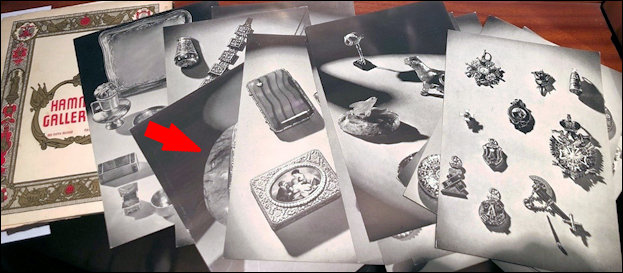
A. Loose Cards Used as Advertising Inserts for Hammer Galleries Merchandise, ca. 193
(Courtesy Ahmed El-Minawi)

CLICK THE ABOVE PICTURE FOR A
LARGER VIEW
B. Imperial Easter Egg with Object Description.
Hammer Galleries, ca. 1938 = $1,800
(2019 Value = $32,700)

C. Miniature Easter Egg with Scent Bottle from the Collection of the
Art Institute of Chicago (Moss Agate, Gold, Enamel, and Cabochon
Rubies, Artist: “Dom Faberzhe [sic]”, 1899, St. Petersburg. Gift of
Mrs. Burton W. Hales through the Antiquarian Society in Memory
of Miss Grace M. Merchant. Reference Number: 1986.1358)
El-Minawi and Hurtt posed these questions while sharing their impressions, long before the colored illustration (C.) was found by Riana Benko:
- Could the monogram be Maria Feodorovna? Hammer was never really good with provenances.
- Could the egg be a “marriage” with the scent bottle added later? There is a later addition of a red velvet lining in the left half of the egg now in an American museum collection.
- The crowned monogram appears rather large and clunky. Fabergé would have used the patronymic part of the initial not just the first initial.
- The egg may be the real thing and perhaps even the scent bottle, but it was not made as the “surprise”. Nor is the crowned initial original.
The acquisition, marketing and advertising schemes used by Armand Hammer (1898-1990), an American business man and art collector with close ties to the Soviet Union and his brother Victor when they headed the Hammer Galleries in New York and Palm Beach during the 1930’s and 1950’s, were less than honorable. For example, “Hammer himself had taken with him from Russia a set of the signature stamps of the Fabergé workshop, so he could doctor unsigned items in the back room of his New York office. He was thus able to expand vastly the supply of Fabergé, or what passed for it.”1 Books describing how Armand acquired “icons, liturgical implements, second rate works of art, and fine objects of Fabergé along with his business dealings”2 are discussed in several monographs:
- Hammer, Armand. Quest of the Romanoff Treasure, 1932. Author describes his travels in the Soviet Union in the early 1920’s and the subsequent export of the Romanoff treasures. Fabergé objects acquired during this time were for sale and exhibited in the 1930’s at the Hammer Galleries in New York City, and in department stores in various cities in the United States.3
- Considine, Bob The Remarkable Life of Dr. Armand Hammer. New York: Harper & Row, 1975.
- Williams, Robert C. Russian Art and American Money, 1900-1940, 1979.
- Blumay, Carl. Dark Side of Power: The Real Armand Hammer. New York: Simon & Schuster, November 1992.
- Epstein, Edward Jay. Dossier: The Secret History of Armand Hammer. New York: Random House, 1996.
- von Habsburg, Géza, et al. Fabergé in America, 1996. Monograph to accompany the traveling 1996-97 exhibition (New York City, San Francisco, Richmond, Virginia, New Orleans, Louisiana, and Cleveland, Ohio). The exhibition and the catalog begin with the history of the Fabergé firm in Russia and the legacy of the Tsars, is followed by the histories and selected objects illustrated from the five major American collectors: Matilda Geddings Gray (New Orleans), India Early Minshall (Cleveland), Lillian Thomas Pratt (Richmond), Marjorie Merriweather Post (Washington, DC), and Malcolm S. Forbes (Collection is now in the Fabergé Museum, St. Petersburg, Russia).
A major difficulty encountered in researching the advertising materials published by the Hammer Galleries are the various formats Armand Hammer utilized – small bound booklets, loose random cards inserted sales catalog folders (interior of front and back covers cut for insertion into pockets), four exhibition catalogs4, and specialized handmade publications to entice the four American lady customers mentioned above. Unfortunately, most of the above advertising tools are without publication dates, and were often used again in his subsequent Hammer advertisements until the object(s) found a buyer. The archival records for the Pratt purchases are digitized and available in the Freeman Library, Virginia Museum of Fine Art in Richmond. Hammer Galleries publications for this treasure hunt were shared by Steve Kirsch, who specializes in identifying forgeries, from the personal collection of Christel McCanless, and the librarian at the Hillwood Estate, Museum and Gardens.
In a Hammer Galleries booklet (ca. 1938) Benko identified in her treasure hunt three genuine Fabergé objects scattered throughout the world:

D.

E.
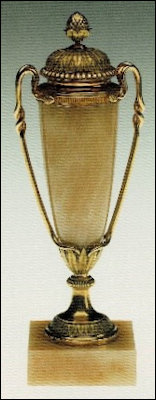
F.
D. – E. Hammer Galleries Publication with Loose Random Insert, ca. 1938. The cover for the photographs in
(A.) does not match the cover above = a sample of Hammer’s unusual merchandising techniques!

Hammer Galleries, ca. 1938 = $675 (2019 Value = $12,283)
F. Fabergé Glue Pot (Rose Jasper, Rose and Yellow Gold, Animal Bristle) by Mikhail Perkhin, 1896-1908
(Keefe, John Webster, Fabergé The Matilda Geddings Gray Foundation Collection, 2008, pp. 110-111)

G.
Hammer Galleries, ca. 1938 = $650
(2019 Value = $11,800) Christie’s
New York, April 19, 1990, Lot 243,
$12,100 (2019 Value = $23,750)

H.

Provenances stated in the Hammer texts are not confirmed
at the present time for either object.

I.
Fabergé Aquamarine Jeweled Brooch by August Hollming, 1899-1908
(McFerrin, Dorothy, From a Snowflake to an Iceberg: The McFerrin
Collection, 2013, p. 182) Over the years described as a rose bud,
thistle, or tulip, exhibited at the 2015 Artistic Luxury at the Legion of
Honor – Fabergé, Tiffany, Lalique venue in San Francisco. Hammer
Galleries, ca. 1938 = $950 (2019 Value = $17,280)

Christie’s New York, April 19, 1990, Lot 243
ENDNOTES:
1 Epstein, 1996, p. 138.
2 von Habsburg, 1996, p. 59.
3 A partial list of the 20 or more cities to which the Hammer brothers took their traveling department store exhibitions from January 1932-1934 is in Lowes, Will, and Christel Ludewig McCanless, Fabergé Eggs: A Retrospective Encyclopedia, 2001, pp. 15-16.
4 Catalogs:
- 1933 – Icon Exhibit of the Hammer Galleries at the Waldorf – Astoria, and Lord & Taylor, both in New York City.
- November 22 – December 22, 1937, Fabergé: His Works, an exhibition in New York City. A total of 348 Fabergé objects were displayed including 11 Easter eggs. All objects have Hammer identification numbers, but are not illustrated. (Readers are advised there are major errors in the egg texts. Lowes and McCanless, 2001, p. 252.) Many objects have suggested Imperial provenances without documentation.
- September 8 – December 30, 1939, Presentation of Imperial Russian Easter Gifts by Carl Fabergé: Court Jeweler to Tsars Alexsandr III and Nikolai II, introduction by H. C. Bainbridge. Benefit: Lenox Hill Neighborhood Association. Nineteen Easter eggs are shown of which 11 were obtained through direct negotiations with the Soviet government. (Readers are advised there are major errors in the egg texts. Lowes and McCanless, 2001, p. 253)
- March 28 – April 28, 1951, Loan Exhibition of the Art of Peter Carl Fabergé, Imperial Court Jeweler, 1846 – 1920 at the Hammer Galleries, New York. Entire proceeds for the benefit of the Damon Runyon Memorial Fund for Cancer Research, Inc. Three Fabergé objects are illustrated added as an addendum- regimental desk clock (#140), sedan chair (#293), and an illustration of a nephrite with lilies-of-the-valley tray (#299).
In compiling this summary about recent Fabergé objects on the market a variety of challenges were encountered – the auction market is changing in that auction data is no longer on the Internet, once an object is withdrawn, does not sell, and more.
The results of a brief survey:
“How Russian Art Became ‘a Growing Beast of a Category’”, Antiques Trade Gazette, April 9, 2019. In an interview with Alexis Tiesenhausen ten landmark sales at Christie’s highlight the dramatic rise of the Russian art market since the fall of communism.
Kinsella, Eileen, and Tim Schneider. “What the Sotheby’s Sale Means for the Future of the Art Industry—and How It Reflects a Broader Shift in Global Economics”, Artnet© News, June 19, 2019. Patrick Drahi’s acquisition of Sotheby’s is the latest in a long line of public companies-gone-private. Here’s what it means…
Crow, Kelly. “Art Speculators Bid to Lose”, Wall Street Journal, May 13, 2019. David Geffen, Peter Brant and other collectors pledge to bid on art they want but new third-party backers aim to reap fees by getting outbid; ‘they don’t know what they’re doing’…
Changes in the availability of auction lot descriptions:
- In some cases if an object is withdrawn or does not sell at auction, the details for the objects are removed from Internet auction sites. Hard copy auction catalogs are the only solution for serious researchers. However, any corrections, additions, etc., published on the Internet or announced at the auction will escape researchers using hard-copy catalogs only.
- Around 1995 the major auction houses began uploading data from their catalogs to the Internet. Content for those early years has been taken down, Christie’s data now begins in 1998, and Sotheby’s in 1999. So, it is best for researchers and art libraries to subscribe and retain hard copy catalogs, and realize errata announced at the auction is not captured in print for posterity.
- Gerlis, Melanie, “Art Business-Auction Catalogues,” Apollo, December 2018, p. 102. “Have printed auction catalogues had their day? As art businesses branch out into other types of content-from in-house magazines to video-and audiences become ever more impatient, this traditional format may soon be obsolete. But at what cost?” More…
- Smaller auction houses are using umbrella agencies to market their “Fabergé” objects. Two years ago the Fall and Winter issue 2017 of the Fabergé Research Newsletter published the following:
“Free-lance arts journalist, Daniel Grant in a 2014 Huffington Post Blog states it succinctly, ‘Christie’s, Sotheby’s and Heritage Auctions all have created their own in-house online bidding platforms, but most every other auctioneer relies on an outside company, the largest being the Manhattan-based LiveAuctioneers…’ Two more internet umbrella agencies active in selling Fabergé objects are The Saleroom, the home of art & antiques auctions affiliated with the Antiques Trade Gazette, and UKauctioneers.”
A. Sold! Fabergé Parasol Handle in the Louis XVI Manner, Workmaster Mikhail Perkhin, £60,000 Plus Buyers Premium (Woolley & Wallis, Fine Jewellery, April 18, 2019, Lot 1453)
B. Sold! Fabergé Chalcedony of a Playful Kitten, Provenance: Caroline, Lady Oppenheimer (1899-1971) £56,312 (US $68,886) with Premium, Length: 3.7 cm, 1 7/16” (Bonham’s London, Russian Sale, June 5, 2019, Lot 110)
C. Sold! £480,320 All Inclusive. Fabergé Miniature Gold, Jade and Rock Crystal Sedan Chair, Workmaster Mikhail Perkhin, Estimate £60,000-£80,000 (Cotswold Auction Company, UK, September 10-11, 2019, all data and stunning photographs gone from the auctioneers website after the sale) Similar Chair in the St. Petersburg Fabergé Museum (Photograph Riana Benko)
D. On the Market! Fabergé Photograph Frame with a “Rare” Translucent Raspberry Red Enameling with a Photograph of Emperor Nicholas II, Workmaster Henrik Wigström. Estimate Upon Request. (Courtesy Erik Schoonhoven)
E. Postcard Under the Hammer! Russian Works of Art, October 30, 2019, with Archival Documents Relating to the Imperial Family. Doyle Auction Preview, Fall 2019, p. 11.

Withdrawn! Furniture of Fantasy – Fabergé Miniature Bonbonnière Table and Chair
(Sotheby’s London, June 4, 2019, Lots 257 and 256, frontispiece, title page, pp. 34-41, no longer on the Internet)

Did Not Sell! Hawthorn Study with
a Henrik Wigström Mark, Fitted
Hammer Galleries Case
(Christie’s London, June 3, 2019,
Lot 217, no longer on the Internet)
The Study of Fabergé’s Hawthorn Sprigs by Christel Ludewig McCanless suggests there are three kinds of hawthorn sprigs with a red and white berry pattern of 6:4, 7:3, 8:2. Where does the hawthorn recently under the hammer fit in? In short:
- The hawthorn offered at Christie’s London, June 3, 2019, Lot 217, did not sell, and is gone from the Internet. It fits into the 7:3 red/white berries pattern which are in the Pratt and Gray Collections (both customers of Armand Hammer). This example is illustrated in a Hammer Galleries sales catalog, ca. 1939.
- A hawthorn sprig offered in 2018 with a 6:4 berries pattern in a diptych case and an estimate of $94,000 to $141,500, a slightly higher estimate then the 2019 sprig, did not sell either.
- A hawthorn sprig with the 8:2 ratio of red/white berries belonged to Mlle. Yzanga del Valle, sister of the Duchess of Manchester, and then the Josiane Woolf Collection, and was identified by A. Kenneth Snowman in Carl Fabergé, Goldsmith to the Imperial Court of Russia, 1979, p. 85.
Geoffrey Munn, an expert on the BBC’s Antiques Roadshow contacted the Royal Horticultural Society at Kew Gardens for a correct identification of the hawthorn plants depicted in Fabergé’s studies. No definitive answers were received. Munn suggested the original Fabergé firm used a delicate steel rod as the center of a flower stalk, over-laid it with gold to imitate nature and to give the delicate and charming flowers the support they need to survive during endless decades of wear and tear – so we can still enjoy them a century later.
Another reader sent an email stating he misses the past sales and exhibitions that used to be listed for objects on the market.
Jeffrey Eger, long-time dealer of auction catalogs, was kind enough to share his experiences of rescuing older (dated) auction catalogs from destruction and has over the years helped fill gaps in hard-copy auction catalog collections.
My thanks to one and all for sharing recent auction news.
A team of Fabergé researchers solved the mystery of pearls on the 1901 Flower Basket Egg in the Royal Collection. The evidence of their keen power of observation is published as an update (August 2019) on the Miek’s Fabergé Eggs website, and in the essay, Fabergé Basket of Flowers Egg: Mystery of Pearls Unveiled by independent researcher, Juan F. Déniz.
Vincent and Anna Palmade, dedicated Fabergé egg researchers, share their Eight Rules for Discovering Fabergé Imperial Eggs and Their Surprises on a new website which “was created in order to bring the latest Fabergé Research from Russia to the attention of those in the west who are interested in the study of Fabergé, as well as to provide reference tools and information not available anywhere else on the internet.”
The Gilded Egg Hunt, 1885-1917 by Friederike von Polenz is a statistical presentation of the Fabergé egg story with an emphasis on the seven lost eggs. Published by Info. Graphics, Berlin, Germany.

Bi-lingual Fabergé Playing Cards
(Photograph Christel McCanless)

Russian Credit Card
(Royal Russia News, May 13, 2019)
Riana Benko shared a bi-lingual deck of Fabergé souvenir playing cards acquired on a recent trip to Russia.
Paul Gilbert, editor and publisher of the Royal Russia News, recently posted the following: “In 2015, the Russian METKOMBANK PJSC and the Fabergé Museum in St. Petersburg, launched a unique co-branding project, Fabergé VISA Cards, …bearing one of five Fabergé Imperial Easter Eggs.”
Newsletter readers over the years have been very generous in sharing movies and more recently Internet video links relating to pre-1918 Fabergé topics. Two websites with specific details:
Annemiek Wintraecken, on her website, has gathered audio-visual information for Fabergé egg collections worldwide, including old black and white Pathé and British Movietone newsreels.
For the years 1971 to 2017, a total of 37 films and videos have been annotated on the Fabergé Research Site. The original VHS tapes and DVDs have been donated to the Freeman Library at the Virginia Museum of Fine Arts (VMFA) in Richmond, Virginia, where the archives of Christel Ludewig McCanless, editor and publisher of the Fabergé Research Newsletter, will reside some day in the future. Any reader who has Fabergé records (films, videos, etc.) they would like donate in order to preserve valuable research resources for future Fabergé enthusiasts, please contact: Courtney Tkacz, Archivist, VMFA
Raiders of the Lost Art: Fabergé Eggs (2014) showcases interviews with Kieran McCarthy of Wartski, Cynthia Coleman Sparke of Bonhams Auction House, and Toby Faber, author of Fabergé’s Eggs, The Extraordinary Story of the Masterpieces that Outlived an Empire, 2008. Richard Parrow (Atlanta, Georgia) writes “… two seasons were made. I am recommending Series 1 Episode 2, Fabergé Eggs. The whole series is available via streaming on Netflix, or on DVD from Amazon”.
John Jenkins, a longtime UK contributor to the newsletter, advised during the 2019 Easter season The World’s Most Beautiful Eggs: The Genius of Carl Fabergé produced and narrated by Stephen Smith, cultural correspondent of the BBC, was shown again. Included in the interviewees are Viktor Vekselberg, Prince Michael of Kent, Tatiana Fabergé, Caroline de Guitaut, Toby Faber, complete with eggs from Vekselberg’s Link of Times Collection. Faber commenting on his participation in the project mentioned, “the production crew and the narrator had very good access to some interesting things. I never met Stephen while the film was being made”. The news story, Carl Fabergé: ‘The Damien Hirst of His Day’ was also shared by John Jenkins, and Alessia Sturli, Milan, Italy.
French film maker, Emanuel Ryz suggests we celebrate the 100th anniversary of Carl Fabergé’s death on September 24, 2020, with a gathering in Paris “with all the passionates of Fabergé”. His dream to have a Fabergé egg film ready for the event is still alive. What other events commemorating the 100th anniversary somewhere in the world are in the planning stages? Contact: Christel McCanless
Christie’s web-based promotionals highlighting the auction house successes over the years:
- Why It’s Time to Discover Russian Art (2017)
- Christie’s, Russian Art 2018
- Collecting Guide: 15 Things You Need to Know about Fabergé (2019)
- 50 Years of Russian Art Masterpieces at Christie’s (2019)
Muntian, Tatiana, Fabergé from the Museum Collections of Russia contains collections from 20 Russian state museums, from the Gokhran, and the Fabergé Museum in St. Petersburg. A number of items especially from provincial museums have been included for the very first time. The Medny Vsadnik Publishing House issued the 2018 book in Russian, English, French, and German editions with different covers. My thanks to Tatiana Muntian (Russia) and Riana Benko (Slovenia) for facilitating that a professional courtesy copy reached me in the USA.


Hardcover and Paperback in Russian

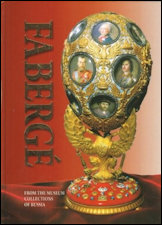

English Editions



French and German Editions
Muntian, Fabergé from the Museum Collections of Russia
(Images Courtesy of John Emerich, Bronze Horseman Books and Riana Benko)



Muntian, Tatiana, with V.S. Voronchenko, General Editor, Fabergé Masterpieces from the Collection of the Link of Times Collection.
First edition in 2014 with reprints in 2016 and 2018. The history for each of the Fabergé eggs in the collection is presented in detail.
Muntian, Tatiana, Fabergé. Easter Gifts, 2018, has also been published in Chinese along with the English and Russian editions. Annotated in the Fabergé Research Site, Spring and Summer 2019 Newsletter under Publications – Books.


Bower Rose Engine Guilloché Machine with Gears and Rosettes
(Courtesy David Wood-Heath; Shevlin, p. 33)
Shevlin, Calina C., Guilloché: A History & Practical Manual, 2017.
A lengthy book review by David Wood-Heath, collector of antique guilloché machine, was published by the Horological Society Journal, January 2019, pp. 14-16.
The R.T. Liddicoat Library at GIA in Carlsbad, California, is a specialized research library for information on the gem and jewelry industry. Our collection has over 65,000 printed works, which includes information on Fabergé.
In November 2016, our library began digitizing out-of-copyright works in its holdings, and making them available online.
Part of our criteria for a book to be digitized is its copyright status. Anything published before 1924 is in the public domain and we can scan it and make it available for free without restrictions. We also take into consideration the physical condition of the book because it will be placed in a book cradle and photographed from cover to cover.
The first books we chose to digitize were our rarest items, i.e., books published in the 1400s through 1700s, and we are now selecting printed materials which are not already available on Internet Archive. One of the library’s more valuable works is Fersman’s Russia’s Treasure of Diamonds and Precious Stones, 1925-26. Not all countries have the same copyright terms. We were able to determine Russia had a shorter copyright term, therefore, we were able to digitize it and make it available. The Fersman portfolio has been covered extensively in the Fabergé Research Newsletter:
- Fall 2010
- Winter 2010-2011
- Spring 2012
- Spring 2013 Updated 2019: Four previously unknown photographs – a diadem, a necklace, a bracelet, and a brooch – from the George Kunz album, but not in the Fersman Portfolio are featured in a United States Geological Survey (USGS) PowerPoint Presentation
- Winter 2015
- Summer and Fall 2016
When an older, but in copyright, gem, jewelry or mineralogy book in our collection is difficult to obtain for the average researcher, and if we receive written permission from the copyright holder, we will scan it. An example is Timothy Adams’ Master of Arts thesis from 1988, Fabergé’s Use of Oriental Motifs
The GIA library is open to all researchers who would like to visit us and study our materials with a few exceptions like the Fersman Album. Our print copy is fragile so we refer library users instead to the digital copy. An appointment is required to view any archived items like Ulla Tillander-Godenhielm’s Russian Imperial Award System, 1894-1917, published in 2005. (Comprehensive book review for the RIAS publication)
Kathy Maxwell of Australia shared a link to a digitized copy of the Christie’s London auction catalog (Wednesday, March 16, 1927) including “part of the Russian state jewels and which have been purchased by a syndicate in this country”. Readers will recognize the Nuptial Crown now at Hillwood Estate, Museum & Gardens (Lot 62 in the digitized copy and discussed in the Fabergé Research Newsletter, Nuptial Crown (not Fabergé) Fall 10 | Summer and Fall 16), and a pair of floral ‘trimming’ pins by Louis David Duval, court jeweler to Catherine II, Lot 35. An identical pair exists in the McFerrin Collection (From a Snowflake to an Iceberg, 2013, p. 187). It is known these trimming pins were made in various designs. Rose Tozer shared a link to a priced auction catalog copy in the GIA library in which successful bidders are listed.
Art historian Timothy Adams is searching for Fabergé objects related to Imperial yachts and cruisers for inclusion in the Fabergé at Sea exhibition he is curating. The venue is to open in May of 2021 at the Catalina Island Museum in California, and then moves to the Houston Museum of Natural Science, November 2021 – July 2022. If you own or know about Fabergé objects made for a yacht, a military cruiser, or were given as presentation gifts on a ship, please advise Tim about a possible loan to this exhibition. Several outstanding objects have already been promised from major Fabergé collections worldwide. Contact: Tim Adams

Imperial Yacht Standart
(Wiki Commons)


Flag Pins and Cufflinks Gifts Presented on Imperial Yachts
(McFerrin Collection)


Cigarette Case Owned by King Farouk I of Egypt
(Courtesy Wartski London)
“The study of hallmarks is a niche subject that attracts a certain type of person. Classifying the marks and deciphering the relations between them appeals to the ordered mind. Hallmarks are governed by regulations, they are methodical, reassuringly certain and cannot be quibbled with. When a new hallmark is found, the desire to identify and assimilate it into the existing system is therefore strong. The Fabergé gold case pictured above was the source of great excitement when brought to Wartski for examination as it bears a previously unrecorded mark.”
Read on for a fascinating research study…
Readers recognized a cigarette case discussed in Finding the Tsarina’s Ledger of Personal Gifts by Elizabeth Jane Timms –
A burnished gold case matching the description above is known from the published Fabergé literature in a variety of ways for the years 1986, 1987, 2000 (black), 2005 (gold, front and open), and 2016 (gold, inside and case closed). The object description states it is a gold with plique-à-jour enamel cigarette case with dragonflies and an inscription.

A. Black: von Habsburg, Géza, et al.
Fabergé: Imperial Craftsman and
His World, 2000, p. 132, Fabergé
Stock # 19234.1

B. Front and Open: Portland, Oregon,
venue entitled, Hesse, A Princely
German Collection, 2005, p. 161, No
Fabergé Stock Number, Inv. # 13002.
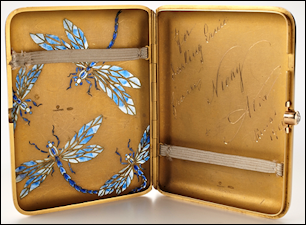

C. Inside and Case Closed: Illustrations from the 2016 Exhibition in the Museum Schloss Fasanerie,
Eichenzell, Germany, Hessian House Collection, Fabergé Stock # 19234.
(Courtesy Hessische Hausstiftung with Inv. No. S 8058 in Fabergé – Geschenke for Zarenfamilie, 2016, p. 124)
Designed in the Art Nouveau style with strong Japanese influence, the dragon fly designs in the cases shows the virtuosity of the Fabergé Moscow branch. Known for its traditional old Russian Pan Slavic enameled objects, and large silver pieces, the Moscow branch also followed fashionable trends. Their sophisticated urban clientele had a passion for modern as well as traditional designs, in this instance it is quite a unique departure from Moscow’s traditional Old Russian style. The Imperial family usually preferred objects in more of a western classical style, influenced by 18th century France and Italy. But occasionally, they fancied something new or exotic. And a few Art Nouveau pieces came into their collections, such as 1898 the Lilies of the Valley Egg. This gold cigarette case with an inscription was purchased as a gift for Empress Alexandra’s brother, the Grand Duke Ernst Ludwig of Hesse. DeeAnn Hoff, independent Researcher (USA), shared interesting details about the Grand Duke: “Ernst Ludwig’s more than ‘admired’ Art Nouveau (in German, Jugendstil), he founded in 1899 the Mathildenhoehe Artist’s Colony in Darmstadt. Clearly, the Jugendstil motif is in recognition of Ernie’s founding this amazing manifestation of his devotion to art.
The charm of the gold case is a process called plique-à-jour enameling done without gold as a backing creating a stained-glass window effect. At first glance the viewer assumes the case (A.) is enameled in black with the dragon flies, while the next three illustrations show the burnished gold case with blue and white dragonflies, and the same sentiment engraved on the inside. Géza von Habsburg advised that he choose for his three publications the illustration with the black background (A.) in which the gold cigarette case was photographed open against the light in order for the plique-à-jour to stand out.
A chronological listing of Imperial purchases from the Fabergé firm confirms the stock number 19234 for a gold cigarette case (A. and C.) and studied in this essay.
Purchased by Alexandra Feodorovna and Nicholas II on November 30, 1900, Golden Cigarette Case. Stock number 19234 for 365 rubles to be split ½ between the Imperial pair.
(Guzanov, A., and R.R. Gafifulin, Fabergé Items of Late XIX – Early XX Century in the Collection of the State Museum of Pavlovsk, 2013, p. 234)
And finally, there is confirmation for this golden cigarette case from an archival ledger belonging to Empress Alexandra Feodorovna recently sold at auction2 and mentioned by Timms in the Royal Central blog at the beginning of this essay.
ENDNOTES:
1 Identical illustrations also in von Habsburg, Géza. Fabergé, Juwelier der Zaren, 1986, p. 154, and the English edition: Fabergé published in 1987, p. 154.
2 Sold for 5,250 GBP at Sotheby’s London, June 5, 2018, Lot 429, Empress Alexandra: A Ledger of the Parcels Sent by the Empress, 1897-1905.
The McFerrin Foundation with the largest private American collection of Fabergé and Russian decorative art objects has encouraged extensive additional research on a wide range of objects on view at the Houston Museum of Natural Science in Texas. The McFerrin’s generosity coupled with the co-operation of researchers world-wide make it possible to publish this PowerPoint summary to encourage further research, and use them as docent training tools:
- Fans
- Gems and minerals
- Imperial presentation gifts
- Smoking accessories
- Overviews of McFerrin Fabergé objects
An additional four PowerPoints about Fabergé drawings (7.), folkloristic hardstone figures (8.), Fabergé in Siam (9.), and Finnish Fabergé workmasters (10.) are known. The dates of each presentation are listed, and no effort has been made to update the research findings presented from the time they were given. If there are other research presentations which have been overlooked, please advise the compiler of this summary. Contact: Christel McCanless
- Folding Fans with Fabergé Montures: Research in Progress by Christel McCanless and Annemiek Wintraecken, Virginia Museum of Fine Arts, July 2011
- Fan research originally published in McFerrin, Dorothy. From a Snowflake to an Iceberg: The McFerrin Collection, 2013, was reprinted with an addendum in the FANA Journal, Fall 2013, pp. 4-11.
- Fabergé Fan Treasure Hunt, January 2015 searched for 23 additional Fabergé fans and information about their leaf artists perhaps known from photographs, auction catalogs, books, and/or original Fabergé design sketches. Thomas DeLeo shared two new finds (Fans with Fabergé Guards Galore!) for the ongoing Fabergé Fan Hunt: Christie’s New York (October 19, 1981) sold Lot 336 as “the most expensive fan of the season for a princely sum $18,000”. Previously, the fan (left below) with a Mikhail Perkhin enameled and jeweled guard realized SFr 10,000 (Christie’s Geneva, April 27, 1977, Lot 407). Based on the CPI Inflation Calculator using the 1981 sale price the 2015 value might be ca. $46,000.




Silk Fan with a Painted Amatory Scene with a Jeweled Guard by Mikhail Perkhin, Active 1896-1903 (Courtesy Christie’s)
Brussels Lace Fan with Tortoise Shell Guard by Mikhail Perkhin (Eberle, Martin, Ein Hauch von Luft und Liebe (A Breath of Air and Love), 2014, Catalog #395)
- Gems and Minerals in the McFerrin Collection, a powerpoint presentation with an accompanying gem and mineral glossary presented by Christel McCanless, Annemiek Wintraecken, and Tim Adams. Fabergé Symposium, Houston, Texas, January 31, 2013. Topics covered:
- 1908 Lapidary workshop at 44 Angliskii Prospekt, St. Petersburg, employing 30 craftsmen by 1912.
- Hardstone animals and Russian folkloristic figures are not always marked Fabergé, unless they have added gold or silver decorations.
- Study goals: Gem and mineral identification and discovery of historical details with examples from the McFerrin Collection divided into Organic Materials from Trees and the Oceans, and Gems and Minerals Mined from the Earth.
- Fabergé Imperial Gifts: Official and Private Presented by Timothy Adams, Houston Fabergé Gathering, 2019.
CLICK THE ABOVE PICTURES FOR PDFS
Both events in Houston, Texas - Fabergé Smoking Accessories: Materials and Techniques of an Art Form by Christel McCanless and Timothy Adams presented at the 2016 Fabergé Symposium in Houston, Texas (PowerPoint Presentation and Handout).
Study Summary:
- The Artie and Dorothy McFerrin Collection containing over 100 smoking accessories made by the Fabergé firm are on loan to the Houston Museum of Natural Science in Texas.
- This study takes a closer look at a selection of cigarette and cigar cases, lighters (both table models and for personal use), and vesta or match cases. Tinder cords were used to light cigarettes and cigars before cigarette lighters became popular. Snuffboxes, usually Imperial presentation pieces, are not included.
- Materials and techniques of two major St. Petersburg studios of the Fabergé firm – Mikhail Perkhin (active from 1886-1903), and Henrik Wigström (active from 1903-1917), are discussed.
- Historical connections for a few accessories are highlighted.
At the 2019 Fabergé Gathering in Houston, the authors of this 2016 PowerPoint presentation were delighted to meet Tricia Starks, who presented us with her new book, Smoking under the Tsars: A History of Tobacco in Imperial Russia, 2018, and a link to her article, A Community in the Clouds: Advertising Tobacco and Gender in Pre-revolutionary Russia.
- Overviews of McFerrin Fabergé Objects:
The Wonder of Fabergé: A Study of the McFerrin Collection by Dorothy and Artie McFerrin, 2016.
- Fabergé in the Light of 20th Century European Jewelry by Ulla Tillander-Godenhielm, Helsinki, Finland, 2016. With a selection of Fabergé objets d’art from the Artie and Dorothy McFerrin Collection Tillander-Godenhielm paid homage to the Russian court jeweler Carl Fabergé (1846-1920) by reflecting on his 34-year career – a surprisingly short time – to accomplish so much. Today, a century later these Fabergé objects are treasured in museums, sought after in the auction market, and in the case of the McFerrin Collection have become a treasure trove for researchers.




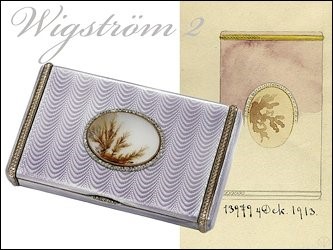

Fabergé Objects in the McFerrin Collection, 2016
- Fabergé Drawings – What we Can Learn from Them? by Timothy Adams, 2018

Presented at the Virginia Museum of Fine Arts, 2018An essay entitled, Fabergé Design Sketches and What They Teach Us, by Timothy Adams, Independent Researcher (USA) discusses the findings in the PowerPoint:
“Three main types of design sketches or drawings were created by the design staff in the Fabergé firm. Each type had a distinctive purpose in the production process. Knowing the purpose of the designs allows more detailed provenance research to take place even a hundred years after the pieces were made.
Working Drawings (A.) were for the craftsmen to use while creating an object, and often had cost or other annotations written on the drafts. One working drawing of a tea set (B.), sold at auction in 1989, has a handwritten notation “Yusupov pot” (the Yusupovs were a prominent noble family). It adds important provenance to the set not known when it sold at auction nine years earlier.
Production Drawings (C.) were drawn into the production albums to document the final product upon completion. The albums were not only a record of what was made, but were also used as inspiration for future pieces.
Client Approval Drawings (D.) were the only drawings seen outside of the workshops. They were created on “speculation” in hopes that a client would like the piece and commission it to be made by Fabergé’s workmasters. Many designs were drawn for the Imperial Cabinet, but not all were approved for production.”
- Windows into Russian Life: Fabergé’s Hardstone Figures by Tim Adams, Christel McCanless, and Annemiek Wintraecken presented at The World of Fabergé in St. Petersburg: 100 Years Ago, Fabergé Museum Symposium, St. Petersburg, Russia, 2014

In Search of Empire: The 400th Anniversary of the House of
Romanov Celebration, New York City, 2013 - Fabergé in the Court of Siam by Christel Ludewig McCanless and Annemiek Wintraecken presented as part of the In Search of Empire: The 400th Anniversary of the House of Romanov event at Columbia University, New York City, on February 15-16, 2013. The Fabergé Collection of the Court of Siam (Thailand since 1939) is one of two original royal Fabergé collections still treasured by the descendants of the original recipients and modern collectors. Strong personal ties between King Chulalongkorn (Rama V, 1853-1910) of Siam and his son, Prince Chakrabongse (1883-1920), and the Romanov rulers, the Tsars Alexander III and his son Nicholas of Russia, were expressed through official diplomatic awards and personal gifts between the two ruling families. An invitation to educate Prince Chakrabongse in St. Petersburg under the tutelage of Tsar Nicholas II and the appointment of the Russian goldsmith Carl Fabergé as Court Jeweler and Enameller to the King of Siam further enhanced these relationships. More…
- In the Living Memory: A Source for My Research on the Fabergé Workshops (Fabergé Research Newsletter, Fall and Winter 2018). Ulla Tillander-Godenhielm from Helsinki reminisces about a research topic she has been studying since 1980 when she was involved in the first Fabergé exhibition in Finland. The PowerPoint entitled, Legacy of the Finnish Workmasters of Fabergé, is based on her 2018 book, Fabergé: His Masters and Artisans. A review of the book written by James Hurtt, Independent Researcher (USA), appeared along with Tillander-Godenhielm reminiscences about Finnish workmasters at the Fabergé firm in St. Petersburg in the newsletter.

Four of Fabergé’s Masters: August Holmström, Chief Jeweler (1857-1903), Henrik Wigström, Head Workmaster (1903-18),
Hjalmar Armfelt, Master Gold- and Silversmith (Active 1904-18), Albert Holmström, Chief Jeweler (1903-18)
(Author’s Collection)
Is it possible that Fabergé objects can be easily overlooked? Any child or adult, who visited the Great British Empire Exhibition, with a record attendance of 1.6 million guests in 1924-1925, or who has been to Windsor Castle and viewed Queen Mary’s Dolls’ House might have noticed a carved nephrite mouse with rose-cut diamond eyes. But how many visitors realized they were seeing an object made by the famous Fabergé firm?

Bedroom in Queen Mary’s Dolls’ House
(Queen Mary’s Dolls’ House: Official Souvenir Guide, 2012, p. 42)
The idea for Queen Mary’s Dolls’ House started with Princess Marie Louise (1872-1956), grand-daughter of Queen Victoria, and daughter of Princess Helena (1846-1923) and Prince Christian of Schleswig-Holstein (1831-1917). Princess Marie Louise had been a childhood friend of the future Queen Mary (1867-1953), and she knew about the Queen’s love of miniatures. The Princess had been granted housing in a Grace and Favor accommodation at Cumberland Lodge in Windsor Great Park following the annulment of her marriage. She had the idea to commission the dollhouse as a way for herself and the people of Great Britain to thank Queen Mary for her kindness and her service during the Great War! The noted architect, Sir Edwin Lutyens, was persuaded to design and supervise the construction of a dollhouse made to a scale 1:12 (one inch to a foot), or just over three feet tall.1 Considering the hundreds of items in this doll house, it is no wonder a tiny, carved nephrite mouse (1.4 x 2.3 x 1.5 cm) is so life-like that one wonders if there are mouse traps set to catch it!
According to Caroline de Guitaut, senior curator of decorative arts of the Royal Collection Trust, this Fabergé mouse was given in 1924 to the Doll House project by Grand Duchess Xenia (1875-1960), daughter of Emperor Alexander III and first cousin of King George V. By this time in 1915 the London shop had closed, so perhaps the Grand Duchess bought it from Wartski or LaCloche Frères, who still had stock for sale. It is said Queen Mary was so enchanted with the little rodent that she asked it be displayed in her miniature private bedchambers. And here it has resided for 95 years! Or was the mouse a part of the famous Sandringham Commission, when King Edward VII in 1907 ordered carved hardstone miniatures of all the animals on the royal estate – with special attention paid to his favorite pets and race horses. After the order was placed, sculptors worked at the Sandringham Estate to make wax models of well over 100 animals. The King gave his approval, then the models were sent to St. Petersburg where they were carved under the guidance of the Russian workmasters. Many of these pieces were sold at modest prices of around 25 to 50 pounds per item through the London Fabergé store (1903-1915) until it closed. It was a very convenient price point when an elaborate gift was not appropriate. In the Royal Archives are purchase records from the Sandringham commission as late as 1912.2
To this day, the wee-little mouse sits in plain sight on the Turner, Lord & Co white cabinet. Aside from the brief removal to the Victoria and Albert museum in 1972 when the mouse was cleaned, it continues to greet thousands of visitors, who happen to spot it nestled among its ornate surroundings. During the Spring of 2019, the entire doll house underwent a conservation/restoration process and is now open. A brief video is online with a quick glance of the mouse in a slightly altered location at 00:37.
ENDNOTES:
1 Queen Mary’s Dolls’ House
2 Much larger gray agate mice up to 6 cm in length, all with diamond-studded ears and tails are known in the Royal Collection Trust (de Guitaut, Caroline, Fabergé’s Animals: A Royal Farm in Miniature, 2010, pp. 111-112), the Mirabaud Collection (Ilych, Alice Milica et al. A Gentleman’s Obsession, 2007, pp. 299, 414), and Bonhams London, The Russian Sale, June 5, 2019, Lot 106. All of them have royal or noble provenances.
Near the entrance of The Last Tsar: Blood and Revolution1 venue at the Science Museum in London a small jewelry album with a connection to Emperor Nicholas II was displayed. A long-standing discussion among scholars dating back to the 1997 publication of The Jewel Album of Tsar Nicholas II by Alexander von Solodkoff was mentioned during the March 2019 London Fabergé gathering. The question: Did the Emperor really paint and annotate for 24 years his jewelry collection? For readers not familiar with the book, a bit of historical background is necessary. Paul Gilbert in Royal Russia News, December 21, 2018, features the album2 and illustrates its content in detail. His introductory paragraph reads as follows:
Joanna Wrangham in a 2012 article, The Jewel Album of Tsar Nicholas II, shared with Fabergé Research Newsletter readers research findings from a book by Professor Igor Zimin which unlocks the mystery of the artist for the illustrations, i.e., Baroness Ekaterina Tiesenhausen rather than Nicholas II. The original Nicholas II jewel album housed in the Kremlin Museums is reproduced as watercolor facsimiles in von Solodkoff with added explanatory texts in English showing the jeweled gifts received by the Emperor Nicholas II from 1889 [age 21] to 1913 [age 45], the year of the Romanov Tercentenary.
Controversial views on the artistic taste of Nicholas II and the authorship of the paintings are mentioned in the von Solodkoff text (p. 63):
– “Nickly draws very well and has a lot of taste.” Grand Duke Konstantin Konstantinovich, Nicholas II’s cousin, a well-known poet and writer, July 10, 1894.
– “Nicholas II was not notable for his artistic taste and he had no pretentions to it.” François Birbaum, chief designer with Fabergé’s firm.

von Soldkoff, The Jewel
Album of Tsar Nicholas II,
1997, Cover

Fabergé Cuff Links with Matching Watercolor Illustration
(Courtesy Wartski)
Igor V. Zimin in his book, Royal Money. Income and Expenses… (2011), suggests the drawings in the original album were done by Baroness Ekaterina Tiesenhausen, the retired lady-in-waiting to Empress Marie Feodorovna. Living in the Freylinskom corridor of the Winter Palace, she did a little “working on part time pictures” for the Emperor. The two entries in the official 1896 Russian Archives (RSHA. F. 525. On. 3. D. 8. L. 37 & L. 109 – Cash Flow Documents and Parish Amounts of His Majesty) state – cufflinks in the book of His Majesty the 3 p. 20 kopecks, and Baroness Tiesenhausen cufflinks in the book of His Majesty 2 Rubles 40 kopecks. Zimin continues, “judging by the manner of writing, it was she who did most of the pictures in the album of the Emperor. Nicholas II from time to time, getting the album and a jewelry chest, quickly tagged by someone, when he received the jewelry gifts”.
Annemiek Wintraecken after our 2019 London Fabergé gathering found more detailed information in a 2013 publication by Igor V. Zimin and Alexander Rostislavovich Sokolov, ювелирные сокровища российского императорского двора (Jewelry Treasures of the Russian Imperial Court.) The book can be viewed at Wikireading.ru. Please note: “The copyright on the materials posted on the site belongs to the authors and is used only for educational and informational purposes.”


Zimin, Igor V., and Alexander Rostislavovich Sokolov, Ювелирные сокровища Российского
императорского двора (Jewelry Treasures of the Russian Imperial Court, 2013)
Two questions remain:
- Where can readers find more information about Baroness Ekaterina Tiesenhausen, the retired lady-in-waiting to Empress Marie Feodorovna, living in the Freylinskom corridor of the Winter Palace, who preserved through her drawings the jewelry collection of Emperor Nicholas II for 24 years for modern researchers?
- Who is the artist for two illustrated albums of jewelry at auction in 2011 belonging to Ksenia (Xenia) Alexandrovna, Grand Duchess of Russia (6 April 1875 – 20 April 1960). PERSONAL ILLUSTRATED INVENTORIES OF JEWELLERY AND BIBELOTS FROM 24TH JUNE 1880 [5 years of age] TO 1905 [age 25], AND OF JEWELLERY FROM 12 JANUARY 1894 [age 18] TO 25 MARCH 1912 [age 32], Sold for £ 181,250 (€ 199,570) inc. Premium. The albums feature almost 1,000 items and contain pictures and supporting annotations for each jewelry item she received from 1880-1912. They also serve as a kind of diary, detailing who presented the Grand Duchess with each piece, and when. Xenia’s albums record 32 years of her jewelry.


Jewelry Albums of Grand Duchess Xenia Alexandrovna, Sister of Nicholas II for 1894-1912
(Courtesy Bonhams, November 30, 2011, Lot 155)
ENDNOTES:
1 September 21, 2018 – March 24, 2019, London Exhibit Features Unique Items on the Last Tsar Royal Russia News, September 20, 2018.
2 Similar essay, Notebook of Tsar Nicholas II with Sketches of Jewelley Items, appeared in Russia Royal News, February 10, 2015.
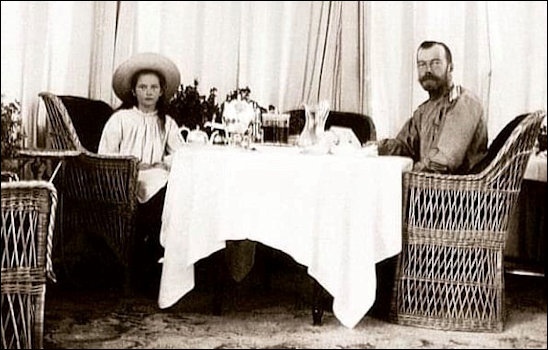
Jim Hurtt, a Fabergé bell push enthusiast, is seeking details on location – Lower Dacha at Peterhof or the
Alexander Palace or Livadia?, verification of the 1906 date, and which daughter is sitting with Nicholas II.
Source of the photograph would also be helpful. Contact: Jim Hurtt
Websites Updates:
- A revamped website by Andre Ruzhnikov illustrates some 40 Fabergé objects with objects descriptions, high quality close-up photographs, hallmarks, stock numbers, and more – a learning tool for the serious Fabergé enthusiast. An online publication entitled Russian Silver. Enamels. Fabergé is on the same website.
- John Atzbach Antiques has unveiled a new website. A unique feature is the retention of the photograph and the description of objects previously sold.
- Cleveland, Ohio. Cleveland Museum of Art
- Houston, Texas. Houston Museum of Natural Science
- Washington, DC. Hillwood, Estate, Museum & Gardens

Fabergé Five-Color Gold Marriage
Cup by Mikhail Perkhin, ca. 1890
(Courtesy A La Vieille Russie)
The Fabergé marriage cup shown by the New York dealer A La Vielle at the TEFAF New York Fall at the Park Avenue Fair from November 1-5, 2019, was chosen by Eve M. Kahn writing in Apollo, October 2019, pp. 52-53, as one of the highlights of the annual fair. The cup appeared at a Park-Bernet New York auction as Lot 30 in December 7, 1967. Final bid was $5,750.
(Exhibition dates change, checking in advance is advised.)
- June 21 – November 3, 2019 The Queen’s Gallery, Palace of Holyroodhouse, Edinburgh, Scotland
Russia, Royalty & the Romanovs
Through war, alliance and dynastic marriage the relationships between Britain and Russia and their royal families are explored from Peter the Great’s visit to London in 1698 through to Nicholas II with portraits, sculpture, photographs, archival documents and miniature masterpieces by Fabergé. The three Fabergé eggs in the Royal Collection are included, and a catalog is available. - September 14, 2019 – March 15, 2020 Hermitage Amsterdam, the Netherlands
Jewels! Glittering at the Russian Court
Venue (Courtesy of Romanov News by Ludmila & Paul Kulikovsky, September 2019, No. 138, pp. 42-44) presents 300 dazzling jewels and more than 100 paintings, accessories, dresses and costumes which together give an impression of the wealth and extravagance of the Russian tsars and the St. Petersburg high society over the course of 200 years. Works on view include a dozen of so objects by Fabergé. Dutch and English catalogs were published. - November 19, 2019 – April 30, 2020 State Historical Museum, Moscow, Russia
Fabergé and the Court Jewellers
The name of Carl Fabergé, the supplier to the Russian Imperial Court and many Royal Courts of Europe, is known to the whole world. A diverse collection of works from the famous company is kept in the State Historical Museum but has never been fully represented. For the first time a variety of artifacts from Imperial Palaces, such as memorabilia, jewelry, works made in different styles, and items from the regimental museums are shown. (Courtesy Galina Smorodina, State Historical Museum)




